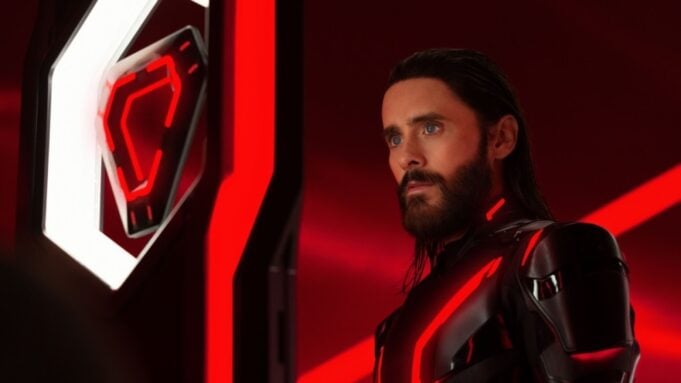There’s more than one paradox built into the program of “Tron: Ares.” Whereas the original 1982 Disney film on which it was based felt ahead of its time — both conceptually and in terms of its then-cutting-edge visual effects — Sean Bailey’s latest attempt to franchise-ify the “Tron” brand reads mostly as an exercise in nostalgia. Like lead actor Jared Leto’s high-def cheekbones, it looks great, but the movie is saddled with callbacks to the earlier film (and the 1980s at large) that suggest it’s aimed more at Gen X than the Alpha kids who could launch the property into the future.
Directed by Joachim Rønning, who previously made overcomplicated sequels to “Pirates of the Caribbean” and “Maleficent” for the company, “Tron: Ares” introduces two great ideas. The first feels alarmist: What if things conceived in the virtual realm (what’s known as “the Grid”) could be transferred over to the real world? So, instead of Jeff Bridges’ character, Kevin Flynn, disappearing into the digital arena, all those sleek vehicles and fancy Programs (like Leto’s Ares) could be 3D printed into existence.
Where that much feels trite in its fear of the direction technology is taking us, the second theory is a refreshing alternative to the kind of anti-innovation hysteria that fuels so many sci-fi movies: What if AI could actually be a force for good? Or, as Encom CEO Eve Kim (Greta Lee) puts it, “What if its major malfunction is just benevolence?” The villain in “Tron: Ares” is not Ares — the new Master Control security software designed to defend the Grid — but his creator, Julian Dillinger (Evan Peters), the unscrupulous head of a rival tech company who’s trying to develop Ares as an (artificially) intelligent, obedient, fully expendable super-soldier.
Though Leto looks cool as Ares with his dark Thor beard and long, slicked-back hair — everything in “Tron” is meant to look cool, and most of it succeeds — the part requires the actor to dial down the humanity to such a degree that he reads like a Manichean mannequin: almost one-dimensional in a film that makes increasingly sophisticated use of 3D technology. (See “Tron: Ares” in stereoscopic 3D if you can, as Rønning clearly recognizes the potential of the format. He also makes the most of Trent Reznor and Atticus Ross’ bassy electro score, attributed here to their band, Nine Inch Nails.)
The same goes for his second-in-command, Athena. In that role, “Queen & Slim” star Jodie Turner-Smith seems to be channeling Grace Jones: confident, fierce and devoid of emotion, on the surface at least. Unlike “Terminator,” which introduced Arnold Schwarzenegger’s character au naturel, “Tron: Ares” keeps flesh and feelings largely hidden from view (this is Disney we’re dealing with, after all). Ares, Athena and the other Programs appear in skin-tight black bodysuits, with luminescent red or blue accents, according to which company they work for: Dillinger or Encom, respectively.
In a demonstration to military clients, Julian uses bright scarlet lasers to render Ares and an intimidating swat truck in his private hangar. “Conjure” might be a better word for it, since there’s a strict 29-minute cap on how long anything brought over from the Grid can last in the real world before it disintegrates. For his business plan to work, Julian needs to find the “permanence code,” a hack Flynn hid somewhere before his disappearance, presumably to protect people from just the kind of technology Dillinger Corporation is developing.
Wearing a visored helmet and blue-and-white snowsuit (in stark contrast with Ares’ more Daft Punk-looking red-and-black motorcycle gear), Eve is actually the first one to find the permanence code, which she wants to use for good. With it, she can render crops to feed the hungry and houses for all that need them, whereas Dillinger wants only power and profits.
Love Film & TV?
Get your daily dose of everything happening in music, film and TV in Australia and abroad.
Therein lies another of the film’s paradoxes: “Tron: Ares” preaches charity, but as with 2010’s “Tron: Legacy” (in which Flynn’s son essentially pirated his company’s OS in an act of anticorporate activism), the reason the film exists is because Disney sees the profit opportunity in unnecessary sequels — to the extent that this one ends by introducing a series of nonsensical loose ends for some future movie to deal with, squandering whatever chemistry was brewing between Eve and Ares.
Artificial intelligence is so easily corrupted in the “Tron” movies that Julian should know better than to place so much autonomy in Ares’ hands (his mother, played by Gillian Anderson, clearly understands as much). His new Master Control starts to rebel almost immediately, resenting that Julian treats him as “100% disposable.” That calls to mind another kid-targeted ’80s movie, “Short Circuit,” or Brad Bird’s far better “The Iron Giant,” in which war machines disobey their programming.
We should consider ourselves grateful that screenwriter Jesse Wigutow wasn’t forced to invent a child character for Ares to befriend, trusting instead in a grown-up relationship between Eve and Ares. Technically speaking, Ares has an infant’s emotional maturity at first, but swiftly develops empathy and other sophisticated feelings. The script references both “Frankenstein” and “Pinocchio,” offering a more pertinent exploration of those two archetypes (vis-à-vis the rise of AI, at least) than Guillermo del Toro’s recent adaptations of both books — if only the film were more committed to Ares’ existential journey.
As president of production at Disney, Bailey effectively pillaged the company’s back catalog (he was responsible for so many of those live-action remakes, franchise reboots and theme park adaptations). While it was exciting to see what “Tron” might look like in the 21st century, the brand gets in the way of Ares’ internal evolution. However fascinating it might be to watch him “level up,” what audiences expect — and what Rønning delivers — are cycle races and dynamic gladiator battles.
The new, wider Light Skimmers look amazing racing through real city streets, while the sight of a red-trimmed Recognizer hovering toward Encom Tower is every bit as thrilling as Patrick Jean’s three-minute “Pixels” short (released the same year as “Tron: Legacy”). But there’s a sense that “Tron: Ares” has too much nostalgia to service, from the cobwebby re-creation of Flynn’s arcade-basement office to Bridges’ extended cameo (as a drawling, laid-back Dude who sounds less like Flynn than his “Big Lebowski” character).
The thing Bailey too rarely dared was hatching original IP, where this film might have actually been more effective as a non-“Tron” original. After all, Tron himself — as in Bruce Boxleitner’s character — is nowhere to be found. Then again, audiences are mostly interested in seeing how Disney has upgraded the franchise in the 15 years since “Legacy,” so maybe it’s best to make like Eve Kim and get with the Program.
From Variety US































